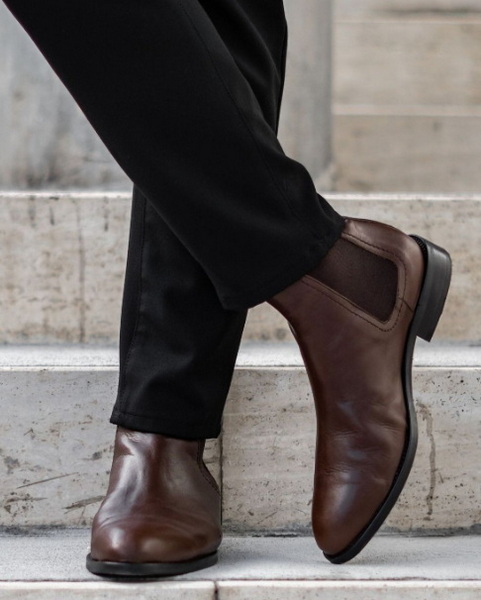Content Menu
● Introduction to Chelsea Boots
>> Key Features of Chelsea Boots
● Understanding Chelsea Boot Sizing
>> UK Sizing
>> US Sizing
>> European Sizing
● How to Ensure the Right Fit
>> 1. Toe Space
>> 2. Heel Fit
>> 3. Elastic Panel Fit
>> 4. Width
● Measuring Your Feet for Chelsea Boots
● Common Fit Problems and Solutions
>> Too Big
>> Too Small
● Styling Chelsea Boots
● Materials and Durability
>> Leather Chelsea Boots
>> Suede Chelsea Boots
● Seasonal Versatility
● Brand Variations
● Care and Maintenance
● Conclusion
● FAQ
>> 1. How Do I Convert My US Shoe Size to UK Size for Chelsea Boots?
>> 2. What Should I Do If I'm Between Sizes?
>> 3. Can I Wear Orthotics with Chelsea Boots?
>> 4. How Do I Know If My Chelsea Boots Are Too Big?
>> 5. How Should Chelsea Boots Feel When I First Try Them On?
Chelsea boots are a timeless and versatile footwear choice, known for their sleek design and ease of wear. However, finding the right size is crucial for both comfort and aesthetics. In this article, we will delve into the world of Chelsea boots, exploring how to determine the perfect fit and addressing common sizing questions.

Introduction to Chelsea Boots
Chelsea boots are characterized by their elastic side panels, which allow for easy slip-on and slip-off functionality. They are typically ankle-high and can be dressed up or down, making them a staple in many wardrobes. The fit of Chelsea boots can vary slightly between brands, but generally, they are designed to fit snugly without being too tight or too loose.
Key Features of Chelsea Boots
- Elastic Side Panels: These provide flexibility and ease of wear, allowing the boots to stretch slightly over time.
- Ankle-High Design: This design contributes to the sleek and streamlined silhouette of Chelsea boots.
- No Laces: Unlike lace-up boots, Chelsea boots rely on their elastic panels for a secure fit.
Understanding Chelsea Boot Sizing
Chelsea boots are available in various sizing systems, including UK, US, and European sizes. Understanding these systems is essential for selecting the right size.
UK Sizing
UK sizes are based on the length of the foot in inches, with each size incrementally increasing by one-sixth of an inch. For example, a UK size 7 is approximately 10.5 inches long, while a UK size 8 is around 11 inches long.
US Sizing
US sizes are similar to UK sizes but generally larger. For men, a US size is approximately one size larger than the corresponding UK size. For instance, a US size 8 would be equivalent to a UK size 7.
European Sizing
European sizes are based on the length of the foot in centimeters, with each size incrementally increasing by 0.66 centimeters. For example, a European size 40 is approximately 25.6 centimeters long, while a European size 41 is around 26.3 centimeters long.
How to Ensure the Right Fit
Ensuring the right fit for Chelsea boots involves checking several key areas:
1. Toe Space
Chelsea boots should have enough room for your toes to wiggle without sliding forward. A good rule of thumb is to leave about a thumb's width of space between your longest toe and the front of the boot.
2. Heel Fit
The boots should cradle your heels without them slipping as you walk. A snug and secure fit is essential to prevent discomfort and blisters.
3. Elastic Panel Fit
The elastic side panels should sit comfortably against your ankles without pinching or gaping. A secure fit ensures the boots are easy to take on and off while maintaining a sleek appearance.
4. Width
The boots should hug your feet without squeezing. If your feet feel cramped, consider trying a wider fit. Some brands offer narrow, regular, and wide options to accommodate various foot shapes.

Measuring Your Feet for Chelsea Boots
To ensure the perfect fit, accurately measuring your feet is essential. Here's how to do it:
1. Gather Your Tools: A piece of paper, a measuring tape or ruler, and a pen or pencil.
2. Trace Your Foot: Place the paper on a flat surface against a wall. Stand on the paper with your heel against the wall, ensuring your weight is evenly distributed. Trace the outline of your foot, marking the tip of your longest toe and the back of your heel.
3. Measure the Length: Use the measuring tape to measure the distance between the heel and the toe markings. Record the measurement in both inches and centimeters.
4. Measure the Width: Wrap the measuring tape around the widest part of your foot, typically the ball of your foot. Ensure the tape is snug but not too tight. Record this measurement.
5. Compare with a Size Chart: Consult the brand's specific size chart, comparing your measurements to their sizes.
Common Fit Problems and Solutions
Too Big
If your Chelsea boots are too big, you might experience heel slippage. Here are some solutions:
- Use Pedag Supra Tongue Pads: These pads can be placed under the insole to fill extra space and improve fit.
- Add an Insole: Adding a leather insole can also help reduce the volume inside the boot.
Too Small
If your boots are too tight, they might cause discomfort or pressure points. Consider sizing up or stretching the boots slightly. Some cobblers offer stretching services for leather boots.
Styling Chelsea Boots
Chelsea boots are incredibly versatile and can be styled for both casual and formal occasions. Here are some tips:
- Casual Look: Pair with jeans and a casual shirt for a relaxed look.
- Formal Look: Match with a suit and tie for a more formal appearance.
Chelsea boots can also be paired with dresses or skirts for a chic, modern look. Their versatility makes them a staple in many wardrobes.
Materials and Durability
Chelsea boots come in various materials, including leather, suede, and synthetic options. Leather is the most common and durable choice, offering a classic look that ages well. Suede boots require more maintenance but can add a sophisticated touch to outfits.
Leather Chelsea Boots
Leather Chelsea boots are known for their durability and style. They can be polished to maintain their appearance and can develop a beautiful patina over time.
Suede Chelsea Boots
Suede Chelsea boots offer a softer, more luxurious feel. However, they require regular maintenance to protect them from water and stains. Using a suede protector can help extend their lifespan.
Seasonal Versatility
Chelsea boots are suitable for various seasons, making them a versatile addition to your wardrobe:
- Winter: Pair with thick socks and a coat for a cozy winter look.
- Spring and Autumn: Match with lighter clothing for a stylish transitional outfit.
- Summer: Wear with shorts or light pants for a casual summer look.
Brand Variations
Different brands may have slightly different fits and sizing. It's important to try on boots from various brands to find the one that fits you best. Some brands are known for their slim fit, while others offer a more relaxed fit.
Care and Maintenance
Proper care can extend the life of your Chelsea boots. Here are some tips:
- Leather Boots: Use a leather conditioner to keep the leather soft and moisturized. Regular polishing can also maintain their appearance.
- Suede Boots: Use a suede brush to remove dirt and stains. Apply a suede protector to prevent water damage.
Conclusion
Finding the right size for Chelsea boots is crucial for comfort and style. By understanding the key areas of fit and using the right sizing methods, you can ensure a perfect fit. Whether you're dressing up or down, Chelsea boots are a timeless choice that can elevate any outfit.

FAQ
1. How Do I Convert My US Shoe Size to UK Size for Chelsea Boots?
To convert your US shoe size to UK size, subtract one from your US size. For example, a US size 8 is equivalent to a UK size 7.
2. What Should I Do If I'm Between Sizes?
If you're between sizes, consider sizing up half a size. This can provide a more comfortable fit, especially if you plan to wear thicker socks.
3. Can I Wear Orthotics with Chelsea Boots?
Yes, you can wear orthotics with Chelsea boots. However, ensure the orthotics fit comfortably within the boot without causing pressure points.
4. How Do I Know If My Chelsea Boots Are Too Big?
If your Chelsea boots are too big, you might experience heel slippage or excessive room in the toe box. Consider using insoles or pads to improve the fit.
5. How Should Chelsea Boots Feel When I First Try Them On?
Chelsea boots should feel snug without being too tight. There should be enough room to wiggle your toes, and the heel should fit securely without slipping.

















